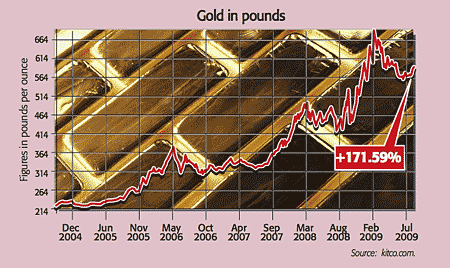
Gold is regaining its lustre. Having trod water for the past few months, it had its best week since April last week, rising by 4.1%. Early in the week it jumped above the $1,000 an ounce mark for the first time since February, not far off its March 2008 high of $1,035. Another slide in the dollar, bullish chart signals and jitters over the strength of the global economy – witness the equities wobble last week – have triggered buying. And the long-term outlook for gold remains compelling.
Investment demand is robust
Demand from investors, the key driver of gold prices over the past year, has ebbed over the past few months as risk appetite has revived. But it remains “very strong”, says the World Gold Council; in the second quarter it was up 46% year on year. And there’s plenty of room for it to grow. For one thing, confidence in the dollar’s status as a reserve currency has been undermined by the Federal Reserve’s dollar printing and the consequent threat of inflation. China and Russia have both called for a new global currency system and a Chinese official this week worried that “the dollar will fall hard”. Both central banks have also been buying gold to diversify their reserves.
Gold is the only safe currency
But gold’s rise isn’t just a dollar story, says John Mauldin on Investorsinsight.com. “The dollar is the worst currency in the world, except for all the others.” Gold is rising in other currencies too. Ongoing money printing by central banks to stave off deflation is fuelling both fears of a relapse into recession and concerns about inflation. While major paper currencies are being debased, gold’s relative rarity means that it can’t be created like dollars, euros or sterling. That’s why it has preserved its purchasing power for thousands of years and achieved its reputation as the ultimate safe haven and store of value – it’s the only safe currency out there. “More and more people are realising the advantages of owning sound money, and that means owning gold.”
If “there is even a hint of worry” that central banks are overstimulating economies, “gold will become everybody’s touchstone”, says Bill O’Neill of Merrill Lynch Global Wealth Management. And if economies appear to be slipping into deflation, central banks are likely to stimulate even more. As David Einhorn of Greenlight Capital says in reference to the US, deflation will lead to “further steps to debase the currency”.
So there is “much to worry about”, says Martin Hutchinson on Breakingviews.com. And it doesn’t take much to move the small gold market: the annual mine supply is worth just $100bn. “A serious increase in investor interest would cause the gold price to soar.”
A massive boost from China
And that’s exactly what now looks to be in the pipeline from China alone. Gold and silver distribution has been strictly controlled in China, but now Chinese television is apparently touting precious metals as an investment opportunity. If 1.3 billion Chinese citizens start buying gold and silver, “even in tiny quantities, imagine what that would do to the market”, says Lawrence Williams on Mineweb.co.za – especially with global gold production “at best flat and probably in decline”.
In the short term, lower jewellery demand thanks to the latest price rise may cause a setback. But with investment demand looking robust even without Chinese citizens buying – which renders worries over lower jewellery demand “irrelevant”, says Robin Bromby in The Australian – the long-term outlook is positive. Both commodities guru Jim Rogers and CLSA’s Christoper Wood see gold hitting $3,500 an ounce; Tim Price of PFP Wealth Management sees scope for gold to “trade at several multiples of its current level in future”. Gold’s eight-year bull run is far from over.